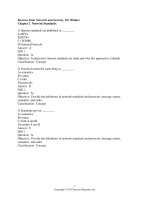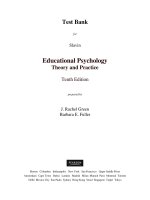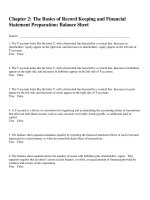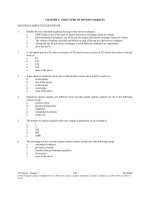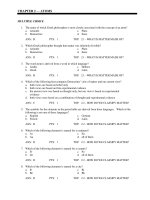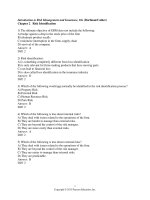Introduction to risk management and insurance 10th edition dorfman test bank
Bạn đang xem bản rút gọn của tài liệu. Xem và tải ngay bản đầy đủ của tài liệu tại đây (170.55 KB, 11 trang )
Introduction to Risk Management and Insurance, 10e (Dorfman/Cather)
Chapter 2 Risk Identification
1) The ultimate objective of ERM does not include the following:
A) hedge against a drop in the stock price of the firm
B) eliminate product recalls
C) minimize interruption in the firms supply chain
D) survival of the company
Answer: A
Diff: 2
2) Risk identification:
A) is something completely different from loss identification
B) is only relevant for firms making products that have moving parts
C) can lead to financial loss
D) is also called loss identification in the insurance industry
Answer: D
Diff: 2
3) Which of the following would not normally be identified in the risk identification process?
A) Property Risk
B) External Risk
C) Human Resource Risk
D) Pure Risk
Answer: B
Diff: 2
4) Which of the following is true about internal risks?
A) They deal with issues related to the operations of the firm.
B) They are harder to manage than external risks.
C) They are beyond the control of the risk manager.
D) They are more costly than external risks.
Answer: A
Diff: 2
5) Which of the following is true about external risks?
A) They deal with issues related to the operations of the firm.
B) They are beyond the control of the risk manager.
C) They are easier to manage than external risks.
D) They are predictable.
Answer: B
Diff: 2
1
Copyright © 2013 Pearson Education, Inc.
6) Which of the following is true about pure risks?
A) The risk/return tradeoff is applicable to pure risks.
B) A firm cannot profit from its exposure to pure risk.
C) Risk managers must be tolerant of negative outcomes related to pure risks.
D) Pure risk is not a source of great concern for risk managers.
Answer: B
Diff: 2
7) Which of the following is true about speculative risks?
A) A firm cannot profit from its exposure to speculative risk.
B) The risk/return tradeoff is not applicable to speculative risks.
C) Risk managers must be tolerant of negative outcomes related to speculative risks.
D) Speculative risk is not a source of great concern for risk managers.
Answer: C
Diff: 2
8) Which of the following is true about direct losses?
A) Does not include smoke damage to a building
B) Is a non-financial loss
C) Has no direct liability consequences for the firm
D) Often is followed by an indirect loss due to business interruption
Answer: D
Diff: 1
9) Which of the following is true about indirect losses?
A) Includes smoke damage to a building
B) Is unrelated to business interruption
C) Often results as a consequence of a direct loss
D) Is a non-financial loss
Answer: C
Diff: 3
10) Which of the following is true about the relationship between direct and indirect losses?
A) The impact of indirect losses can be much bigger than the original direct loss.
B) They are unrelated events.
C) Direct losses are the result of an indirect loss due to business interruption.
D) Indirect losses are irrelevant compared to direct losses.
Answer: A
Diff: 2
2
Copyright © 2013 Pearson Education, Inc.
11) If a private elementary school having a single building were to lose the building in a tornado,
it is likely that the largest category of loss would be:
A) property taxes
B) indirect loss of income and continuing expenses until school returns to its normal status
C) liability loss
D) key personnel loss
Answer: B
Diff: 2
12) Which of the following is true about indirect losses?
A) A lawsuit is a good example of an indirect loss.
B) They can have a spill-over effect to other product lines.
C) They are only a result of significant property losses.
D) Indirect losses are irrelevant compared to direct losses.
Answer: B
Diff: 3
13) Which of the following is true about pure risks?
A) They are also known as hazard risks.
B) They are completely unrelated to hazard risks.
C) Are only recently being considered by risk managers.
D) Consist of Property and associated Human Resource risk only.
Answer: A
Diff: 2
14) Which of the following is an appropriate method for calculating the financial impact on the
firm that results from the loss of a key employee?
A) Research comparable salaries on employment data websites
B) Never let these employees be in the same building at the same time
C) A multiple of the key person's salary
D) Calculate the net present value of the future salary owed to the employee under his/her
existing employment contract
Answer: C
Diff: 2
15) Property Risk:
A) is an example of a speculative risk
B) is an example of an indirect risk
C) only relates to buildings
D) is an example of a pure risk
Answer: D
Diff: 2
3
Copyright © 2013 Pearson Education, Inc.
16) Which of the following is not true about property risks?
A) They can cause financial harm to the firm.
B) They encompass tangible and intangible property.
C) They do not include the reputation of a firm.
D) They also refer to damage to the property of others.
Answer: C
Diff: 2
17) Losses related to intangible property does not include:
A) patents
B) inventory
C) human capital
D) reputation
Answer: B
Diff: 3
18) All of the following can result from a damaged reputation, except:
A) declined earnings
B) lower cost of capital
C) lower credit rating
D) smaller market share
Answer: B
Diff: 1
19) Why is the damage to the property of others also relevant for a firm?
A) It is a speculative risk.
B) Since a firm needs to pay for the damage to the property of others
C) Due to the complex supply chains upon which firms rely
D) It is not relevant at all.
Answer: C
Diff: 2
20) Why do supply chains complicate the ERM process?
A) They lead to higher human resource risk.
B) They lead to higher speculative risks.
C) A disruption somewhere in the supply chain affects the operations of a firm.
D) They do not complicate the ERM process at all.
Answer: C
Diff: 3
21) According to a survey, which of the following is the most challenging risk to manage?
A) Human resource risk
B) Third-party liability
C) Speculative risk
D) Reputation risk
Answer: D
Diff: 2
4
Copyright © 2013 Pearson Education, Inc.
22) Which of the following is not true about liability risks?
A) Liability risk is where the firm may be legally responsible for the harm it causes to another
person.
B) Liability risks are sometimes overlooked due to their intangible nature.
C) Only a breach of contract and criminal acts can lead to liability risk for a firm.
D) A tort can lead to a liability risk.
Answer: C
Diff: 3
23) Assume Gerald is injured because his landlord, Barbara, fails to replace burned-out light
bulbs in the hallway of his apartment building. If Gerald trips and falls and then sues Barbara for
his injuries, the basis of his suit most likely will be:
A) negligence
B) intentional interference
C) res ipsa loquitor
D) breach of contract (lease)
Answer: A
Diff: 2
24) All the following are objectives of risk management except:
A) to insure all exposures to loss
B) minimize reputation risk
C) minimize supply chain interruption
D) develop and maintain plant safety program
Answer: A
Diff: 2
25) All of the following legal doctrines result in more individuals being held liable for
negligence except:
A) last clear chance rule
B) contributory negligence
C) comparative negligence
D) vicarious liability
Answer: B
Diff: 3
26) In a negligence lawsuit, the jury's primary function is to:
A) assist the judge in interpreting the law
B) determine the facts
C) decide guilt or innocence
D) make sure neither plaintiff nor defendant cheats in presenting their case
Answer: B
Diff: 2
5
Copyright © 2013 Pearson Education, Inc.
27) A plaintiff will generally collect for negligence when all the following characteristics are
present except:
A) injury is suffered by the plaintiff
B) plaintiff breaches a contract with the defendant
C) breach of duty owed the plaintiff
D) the breach of the duty caused the injury to the plaintiff
Answer: B
Diff: 1
28) Which of the following statements about liability losses is true?
A) They arise from two sources: the obligation to pay legal damages, and the resulting bad
publicity.
B) The obligation to pay legal damages is always more expensive than the cost of defense.
C) Defense costs can be expensive, unless the court finds that the plaintiff's claims are
groundless.
D) None of the above is true.
Answer: D
Diff: 3
29) In making your personal risk management decisions, which method would be the most
feasible and the most economical for handling chipped windshields on your automobile?
A) Avoid (don't drive)
B) Retain (pay for them yourself)
C) Insure (file a claim under your auto insurance)
D) Expose (remove your windshield from your car)
Answer: B
Diff: 3
30) Which one of the following lists presents the three major categories of "legal liability"?
A) Breach of contract, res ipsa loquitor, torts
B) Criminal wrongs, product liability, intentional interference
C) Torts, breach of contracts, liability without fault
D) Breach of contracts, torts, criminal wrongs
Answer: D
Diff: 2
31) The "reasonable person" standard changes based upon which one of the following factors?
A) The extent and dollar amount of the injury that occurs
B) The defendant's professional status relative to the event causing the injury
C) The defendant's criminal record
D) The insurer's duty to defend the policyholder
Answer: B
Diff: 2
6
Copyright © 2013 Pearson Education, Inc.
32) Kim's automobile is struck by a negligent motorist. She suffers bodily injuries that cause her
to have $73,000 in medical expenses. She is unable to work for several weeks and loses $10,000
in wages. The repair bill to fix her car is $20,000. Choose the true statement from the following
answer choices:
A) Her medical bills and lost wages are personal injuries.
B) Her repair bill for her automobile is an example of property damage.
C) Her lost wages are personal injuries, while her medical bills are bodily injuries.
D) ALL of her losses in this scenario are classified as personal injuries, since they were caused
by another person.
Answer: B
Diff: 3
33) Foster is suing Geraldine and they are in a contributory negligence state. Foster's total
injuries are $100,000, and the jury finds that he was 5% at fault in the incident. How much
money will Foster be entitled to collect?
A) $100,000
B) $95,000
C) $0
D) $90,000
Answer: C
Diff: 3
34) Which of the following is not a tort?
A) Battery
B) Assault
C) Negligence
D) Breaking a contractual agreement
Answer: D
Diff: 2
35) To estimate potential property losses, risk managers must know:
A) the accounting book value of property
B) the replacement cost of property
C) the actual cash value of property
D) the original purchase price of property
Answer: B
Diff: 2
7
Copyright © 2013 Pearson Education, Inc.
36) The Big Boy Toy Company's best seller is a futuristic radio-controlled car. The toy is
manufactured using a custom mold designed especially for the company by a local artist. If
anything were to happen to this mold, the company would have to stop manufacturing the toys
until the artist could reproduce the mold. The risk manager's primary concern regarding damage
to this mold is probably the:
A) indirect loss that will result while production of the toy is halted
B) expense of paying the artist to reproduce the mold
C) extra cost of manufacturing additional toys while the car cannot be manufactured
D) direct damage to employees that will be laid off while production is halted
Answer: A
Diff: 3
37) It is important for a retail store to quickly resume operations after a direct loss primarily
because:
A) looting will occur
B) retail merchandise goes out of style quickly
C) most property insurance contracts demand that operations resume immediately, or as soon as
possible, after a direct loss
D) customers can be quickly and permanently lost if operations do not continue
Answer: D
Diff: 2
38) Damages awarded to compensate for pain and suffering are called:
A) punitive damages
B) personal injuries
C) non-bodily injury damages
D) exemplary damages
Answer: D
Diff: 2
39) Workers' compensation covers all of the following losses except:
A) medical expenses resulting from a job related injury
B) rehabilitation expenses resulting from a job related injury
C) lost wages during a disability that results from job related injuries
D) medical expenses resulting from an at-home accident
Answer: D
Diff: 2
40) All of the following are considered a financial risk handled by financial risk management
except:
A) currency risk
B) liquidity risk
C) product marketability risk
D) commodity price risk
Answer: C
Diff: 2
8
Copyright © 2013 Pearson Education, Inc.
41) Enterprise risk management is concerned with:
A) both pure and speculative risks
B) insurance contracts
C) pure risks
D) subjective risks
Answer: A
Diff: 1
42) Which of the following is not a risk identified in a typical Vulnerability Map?
A) Hazard Risks
B) Negligence Risks
C) Operational Risks
D) Financial Risks
Answer: B
Diff: 1
43) A sushi bar is concerned about lawsuits from customers who may become ill after eating raw
fish. Avoidance is not an option, since a sushi bar's main product line is raw fish. Which of the
following would be the most practical loss prevention technique the restaurant could use?
A) Posting a sign in the restaurant that says "Not responsible for anything"
B) Requiring each customer to sign a legal waiver before serving them sushi
C) Posting a warning on the menu that explains the risks of consuming raw fish
D) Training servers to identify patrons who are feeling ill
Answer: C
Diff: 3
44) Which of the following statements about financial risks is not true?
A) Many financial risks are attributable to fluctuations in value.
B) Financial risks arise from events that prevent a firm from conducting its normal scope of
operations.
C) An example of a financial risk is one associated with unfavorable credit rating.
D) Price risks associated with input costs are a form of financial risk.
Answer: B
Diff: 3
45) Most financial risks are insurable.
Answer: FALSE
Diff: 1
46) Leasing is an example of risk identification.
Answer: FALSE
Diff: 2
47) A person can be found negligent even though his failure to perform some act was
unintentional.
Answer: TRUE
Diff: 2
9
Copyright © 2013 Pearson Education, Inc.
48) A breach of contract legally is known as a "tort."
Answer: FALSE
Diff: 2
49) Loss reduction and loss prevention are not the same thing.
Answer: TRUE
Diff: 2
50) Risk avoidance and loss prevention are the same thing.
Answer: FALSE
Diff: 1
51) The plaintiff in a negligence suit is the party who allegedly injured the defendant.
Answer: FALSE
Diff: 1
52) The damage caused by an indirect loss can be greater in amount than the damage caused by
direct loss in the same occurrence.
Answer: TRUE
Diff: 1
53) If assumption of the risk is established, it means the defendant usually must pay for damages.
Answer: FALSE
Diff: 2
54) Workers' compensation insurance covers both job-related injuries and occupational diseases.
Answer: TRUE
Diff: 2
55) From the employer's standpoint, workers' compensation insurance may be seen as a
substitute for other types of liability insurance.
Answer: TRUE
Diff: 2
56) An ethics violation is an example of a strategic risk.
Answer: TRUE
Diff: 1
57) All external losses are random.
Answer: FALSE
Diff: 2
10
Copyright © 2013 Pearson Education, Inc.
58) Provide a statement of the overall goal of the risk management function.
Answer: The overall goal of the risk management function is to make efficient pre-loss
decisions to prepare for the post-loss financial consequences of losses in order to minimize the
overall impact (disruption) to the firm and dollar losses.
Diff: 2
59) What is the difference between compensation for personal injuries and punitive damages?
Answer: Personal injury damages pay for damages to a person's rights, such as a loss of
reputation or release of confidential information. Punitive damages are awards made to plaintiffs
as a means of punishing defendants for outrageously offensive acts. Punitive damages imply
gross negligence or the total disregard for the plaintiff's safety.
Diff: 2
60) What are the requirements for a plaintiff to prove negligence against a defendant?
Answer: The plaintiff must show 1) the defendant had a legal duty to protect the plaintiff, 2) the
defendant failed to perform that duty, 3) an injury was the result of the defendant's failure to do
his or her duty.
Diff: 2
61) Given a broad definition of legal liability, what are the three legal categories for describing
situations in which one person injures another? Which ones are generally insurable?
Answer: The three categories are: torts (a civil wrong done to another), breach of contract
(breaking a legally enforceable contract), and criminal wrongs (crimes against society). Many
torts are insurable. Criminal wrongs and breaches of contracts are not.
Diff: 2
11
Copyright © 2013 Pearson Education, Inc.

